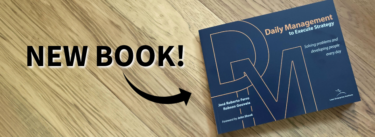Dear Gemba Coach,
I am in charge of a service activity and have started a lean approach with a sensei. In our last gemba tour, one of my staff got very upset about the fact that we seem to point out only the negatives and never recognize all the good work they do. The area was a mess, and most of the discussion was with her direct manager, but I feel she’s got a point. I’m curious to hear your thoughts on the matter.
Difficult question, indeed, and a real one. First of all, lean is not designed to upset people. And yet hurt feelings and discouragement are often unfortunate by-products of a disciplined lean approach. Especially when individuals feel challenged, or unable to meet constant new demands, they will see the new program as something seeking blame—looking for “who?” rather than “why?” In fact, every time someone gets emotional we, as a whole, lose points. This needn’t be the case. The aim of lean work is to reinforce mutual trust between staff and management, not to create more pressure on employees. Of course this is easier said than done, so let’s explore just how to tackle this challenge.
Your question highlights a fundamental conundrum about managing people. On the one hand, people need positive feedback and recognition to feel motivated at work. On the other hand, it sounds false to recognize people for just doing their job. Worse, if (in order to protect their self-esteem and bolster their confidence) we give positive feedback to people who are actually doing a poor job, we create an environment of lowered expectations in which no one is going to improve any time soon. It is tricky.
Praise and Performance
What does science say? Rodd Wagner and Jim Harter, who are researchers for the Gallup organization, have conducted literally millions of interviews for their studies. They found conclusively that while each employee may be motivated by any number of different things, every single one seeks that surge of dopamine. And yet they find that praise is rare in business settings. Their findings show that in many workplaces you will find one-fifth to one-third of employees disagreeing with the statement “In the last seven days I have received recognition or praise for doing good work.”
Furthermore, the researchers find that regular praise and recognition boosts business performance. In one large healthcare organization, a difference of 10 percentage points on the recognition statement represented an average improvement of 11% on patients’ evaluations of their experience. In one investment firm, the difference between half of its investment advisors feeling recognized and one-third feeling that way represented an 11% boost in revenue — millions of dollars. A large, multi-company analysis puts the average benefit of such a shift in recognition at 6.5% greater productivity and 2% higher customer engagement. (See: https://news.gallup.com/businessjournal/28270/The-Fourth-Element-of-Great-Managing.aspx)
Yet aspiring to these healthy work environments seems to pit two basic lean principles against each other. On the one hand, we need constant challenge to develop the kaizen spirit; and on the other, mutual trust depends on recognizing or praising employees for doing good work often. At the gemba, how can we resolve this difficulty?
If we take this problem to the gemba, I believe the first step is in fact to develop a shared understanding of what exactly we mean by “good work.” In lean, proficiency at any job is measured on the following four levels:
- Being able to do the job at quality standards
- Being able to do the job at quality standards within the standard cycle
- Being able to solve problems and offer improvement suggestions on the job
- Being able to teach the job to someone else.
Level one and two deal with the working environment as much as the person. Does the workplace enable individuals to understand how to distinguish good work from bad work? Are people able to articulate and identify the standard cycle? In many cases, and certainly in service, this often hasn’t been defined by management, which makes it very difficult for employees and managers alike to distinguish a good job (and worthy of praise) from a bad job. In many places, people simply rely on more exertion as a means of doing better.
Wired for Blame
Your employee’s reaction raises questions about her direct manager. Does he or she realize the importance of continually letting people know how they’re getting on? Or does he or she assume they are getting on well, therefore focusing on other things? Furthermore, is it clear at the gemba how one can succeed at one’s job? Are targets clear and can staff see what their job cycle is? Is it easy to see the difference between a good job and a bad job; or is this left to the judgment of each employee?
In other words, it’s the direct manager’s job to create opportunities to recognize or praise workers frequently. Thanking, praising, recognizing when things go right rarely comes naturally to any of us. We’re wired to respond angrily to problems, and to blame the person for the situation. Knowing that, you have to make a deliberate effort to go out of your way to praise people or at the very least, listen to them, especially about what they do right. As we don’t want to praise people for doing the wrong job or not keeping to the cycle, it is important that the lean tools are in place at the gemba to make sure we recognize people doing the right thing.
What of the sensei visits in the workplace? It’s a fact that sensei visits can be scathing because the sensei’s job is to define the next “target conditions” in Mike Rother’s terms – drawing the next line in the sand to stretch people and support the kaizen spirit. To many people, this can be received as criticism (which assuredly, it is not). So as a senior manager, where and how can we praise people during a sensei visit? Just doing their work is not a very good candidate because the sensei has, in all likelihood, just pointed out all abnormal situations that need attention, and the sluggishness of response in others. Finishing by saying “good work everybody” is likely to sound false, or as corporate-speak.
On the other hands, a sensei visit is a perfect opportunity to reinforce the higher levels of competence: solving problems and making suggestions and teaching others. During the gemba visits, it makes sense to actively look for actual problems that have been solved by people and to praise them for their efforts on this aspect of their work. This does not necessarily come naturally, as it’s easier to see the current conditions, and discuss what needs to be developed. Yet, during gemba visits, one can learn to ask systematically about recent problems solved and recognize people for their efforts (as well as coaching them).
People tend to believe one of two things about their ability. Either they believe that competency is fixed and they need to demonstrate this every day, staying clear of problems they can’t solve. Or they believe that competency is the result of hard work and being patient and persistent in tackling problems they don’t know how to solve just yet, but will one day. When you listen carefully to what people tell you at the gemba, it’s relatively easy to see which camp’s colors they’re flying. As a senior manager, praising people for just doing their job is problematic in the extreme, because that’s the end of kaizen. On the other hand, praising people constantly for solving problems and making suggestions is the key to bolster confidence in the kaizen process, and, in doing so, deepen the mutual trust that, together, we will face our challenges and overcome them – and learn.
Maintain the Positivity Ratio
Let’s go back to the gemba. What is really praiseworthy in lean practice? First, seeing problems in one’s own area. Second, working with the team to understand the problem in detail. Third, trying new things to solve the problem right away. Fourth, improving the local standard. In fact, there are many opportunities to recognize the work people do and praise them, which start with the production analysis board or the kaizen board. The first technique to master is confirmation: agreeing with people that the problems they have spotted are properly phrased. In a lean environment, it’s usually easy to praise and recognize people for their sincerity in trying to spot problems and solve them. They might not always succeed, but most of them do try to flag issues.
All in all, the advice of the sensei remains relevant today. Improvement can be started at any point today, no matter what by:
- Encouraging people to practice one-by-one confirmation
- Listening to frontline staff
- Trusting them to do the right thing
- Supporting them in solving problems
The hardest thing in lean is getting operators to “stop the line” or at the very least, speak up when confronted with a difficulty. This is also a great opportunity to recognize people because you can thank them every time they bring up a problem. With this in mind, there are many opportunities to maintain the positivity ratio of three positive comments to one negative one. If you can’t find three positives to say for every negative you must say, then you have a problem of another order and must look up the management food chain to figure out what is going on.






